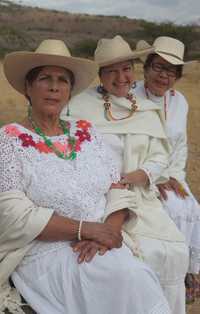The Mujeres Cardencheras group will record 40 compositions of this traditional oral song.

The Mujeres Cardencheras group will record 40 compositions of this traditional oral song.
From the Editorial Staff
La Jornada Newspaper, Saturday, June 21, 2025, p. 5
At the foot of the Tepehuanes mountain range in Durango, a group of women is working to preserve one of the oldest musical heritages in northern Mexico: the cardenche song.
The Mujeres Cardencheras ensemble, led by Alma Leticia Montenegro García, was selected by the 2024 Traditional Mexican Musicians call to transcribe 40 Cardencha songs that they have collected throughout their career into musical notation.
Together with María Guadalupe Ríos Herrera and Catalina Bañuelos Chávez, Montenegro is developing the project Anthology of Serrano Salted Beef, which seeks to ensure that its song, full of history, melancholy, and beauty, is not lost in oblivion.
Cardenche singing is a musical tradition that has been passed down orally from generation to generation, allowing it to survive for over 300 years. However, the lack of formal records and the decline in the number of original performers have jeopardized its survival.
Cardenche singing has no formal registers because it's spontaneous, not improvised in the conventional sense. We inherited it from our grandmothers, hearing it in the streets, at churches, and at funerals. There were no scores; it was all learned by ear
, says Montenegro.
Its oral transmission, adds Alma Leticia, represents one of the main challenges of the project: converting a free chant, without fixed metrics, into a traditional notation system.
When other young people try to play it online, they end up making up tunes. The sheet music will help preserve the real melodies, even if some of their original freedom is lost
, he explains.

▲ The ensemble includes Catalina Bañuelos, Alma Leticia Montenegro, and María Guadalupe Ríos from Durango. Photo courtesy of the Federal SC
Contrary to the common belief that cardenche singing was exclusive to men, Montenegro emphasizes the historical role of women in its practice. We've always sung. The problem was that we were relegated, but our tradition dates back to the brotherhoods of the 18th century. We've had it since we were children, since we were six years old
.
Older women have played a fundamental role in preserving the cardenche song, learning to read and write so as not to forget their musical memory.
The Anthology of Serrano Cardenche Tasted Meat is an intergenerational effort that seeks to preserve the cardenche song. "We are very grateful to the programs that have supported us, because thanks to them, we can achieve something that previously seemed impossible: to record what was always only in memory."
We bring our mountain hearts, our songs, our memories to the table. This isn't for us: it's for everyone
, the artist concludes.
According to the 2024 Mexican Traditional Musicians call, from the Creation System, an institution of the federal Ministry of Culture (SC), the resulting material will be disseminated through institutional media and will serve as a pedagogical and preservation tool for future generations.
Students from La Esmeralda showcased their fusions of art and fashion on the catwalk.
Barbara Hoyos
La Jornada Newspaper, Saturday, June 21, 2025, p. 5
The National Center for the Arts (Cenart) hosted the Radical Fashion show, in which members of the La Esmeralda National School of Painting, Sculpture, and Engraving broke new ground by combining fashion and art.
The artistic dialogue, held as part of the Beyond the Rainbow program, was led by teacher Abigail Maritxu's fashion workshop. Both graduates and students sought to propose a shift in traditional and academic forms of artistic creation.
The purpose of the runway show was to reflect on technology and social media, and how they affect body perception and modification.
Luis Albarrán told La Jornada that his work, titled Hayabusa, was created out of his interest in blending technology and a futuristic vision, so he sought to combine the attributes of an eagle and the potential of a motorcycle, similar to the current Japanese aesthetic.

▲ One of the artistic dialogue proposals presented by the students at the Cenart facilities. Photo by Carlos González Benítez
The artist said it is important for Cenart to open its spaces to students to exhibit their work and create a community, since it is often not possible to access other institutions
.
For his part, Farlopa opined: "Contemporary artists urgently need to update their ways of working; my need as a sculptor has led me to experiment with three dimensions through clothing and materialize it as a pictorial piece
."
jornada




